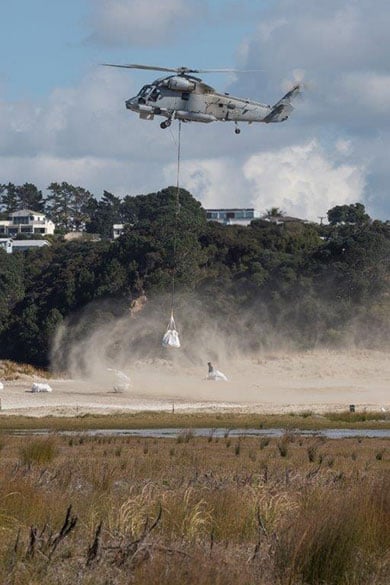Tara iti typically build their nests on exposed, low-lying areas of shell-covered sand. These new nesting sites were made by transporting 50 tonnes of locally sourced shell into safe sites by New Zealand Defence Force (NZDF) helicopter last week, who used the operation as a training exercise.

Fairy tern shell operation at Mangawhai
Image: NZ Defence Force
The operation was funded by The Shorebirds Trust and supported by the Tara Iti Golf Club, NZDF, local iwi Ngāti Whātua o Kaipara, Te Uri o Hau and Ngāti Manuhiri.
"We created new shell nests for the birds last year and had success with one pair laying an egg. When you are talking small numbers of birds, one success, like using a safer nest to breed, is a huge step forward. Other than predator control, habitat enhancement is the most important action that can be taken to ensure tara iti survival," says Ayla Wiles, Department of Conservation (DOC) Biodiversity Ranger.
"The new shell patch breeding sites have created safer places for tara iti to nest on, protecting them from tidal inundation and sand blow," she says. "In the past we've had nests impacted by high winds, which means parent birds can't find their eggs and king tides wash nests away. The new sites are placed in the rear of the dunes, providing more protection for chicks and their parents.
"Support for our most endangered bird by community groups and local hapu and iwi is essential for their survival. I would like to acknowledge the contribution of The Shorebirds Trust and those who partnered with them to get these new shell nests created, and the ongoing work of the recovery group," says Ayla.
Tara iti are critically endangered. The total population of this species is fewer than 40 birds.
Background information
Tara iti used to nest on beaches right round the North Island coast and on the east coast of the South Island. Introduced predators (feral cats, rats, stoats, ferrets and weasels), habitat loss and human disturbance have brought them to the brink of extinction.
Tara iti now have just four main nesting sites: Papakanui Spit, Pakiri Beach, Waipu and Mangawhai sandspits.
To protect tara iti at their nesting sites, please following these simple rules:
- Stay out of taped off or fenced areas and use designated walkways
- Take a wide berth around nests and chicks
- Keep dogs on leads
- Remove bait and rubbish from the beach to deter rats and other predators
- Drive vehicles below the high tide mark
Tara iti recovery programme
DOC works closely with The Shorebirds Trust, The New Zealand Fairy Tern Charitable Trust, About Tern, Birds New Zealand, Waipu Trapping Group, NZDF, Tara Iti Golf Club, Ngāti Whātua o Kaipara, Te Uri O Hau, Ngāti Manuhuri and Patuharakeke to help protect tara iti.
Tara iti nest on beaches during summer between October and February. They create a nest by scraping a small hollow in the sand. This means their eggs and chicks are very vulnerable. DOC and volunteers fence off the four nesting areas and erect signs asking the public not to enter the sites.
DOC also employs seven summer rangers during the breeding season. At least one ranger is assigned to each breeding site to monitor and protect Tara iti nests during the nesting season. They also control predators at each site and talk to the public about protecting these rare birds. This work is supported by dedicated local volunteers.
Eggs are transferred between nests to maximise the productivity of the breeding pairs of adult tara iti, with Auckland Zoo providing facilities to incubate the eggs.
Since the recovery programme began, the number of tara iti has risen from a low of just three recorded breeding pairs in 1984 to nine breeding pairs producing seven chicks in the last season.






